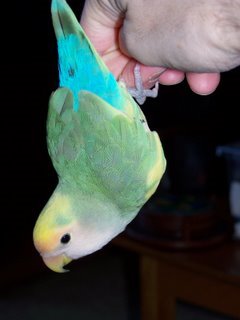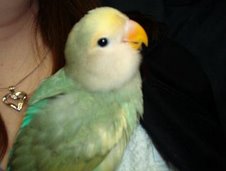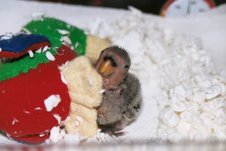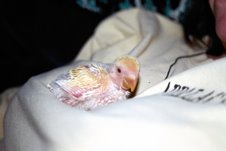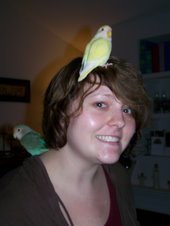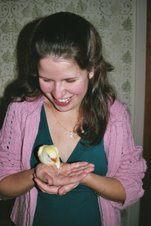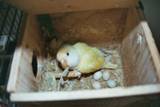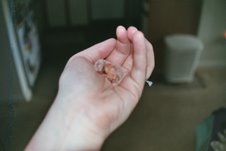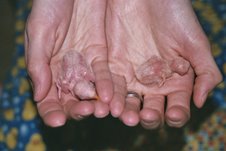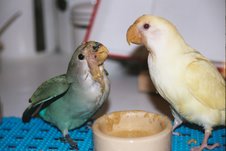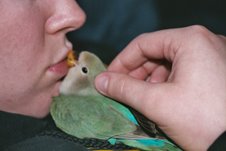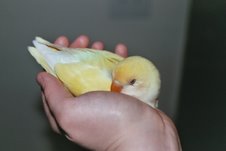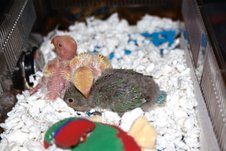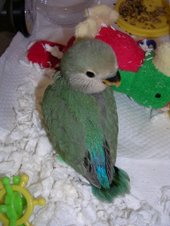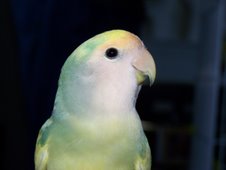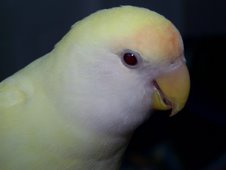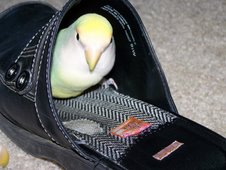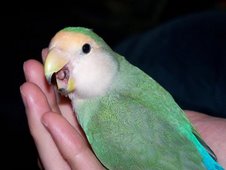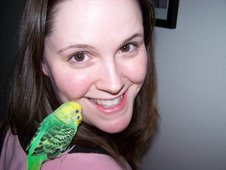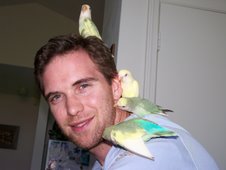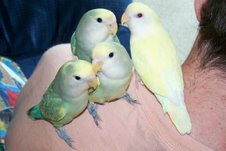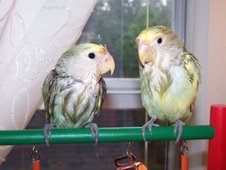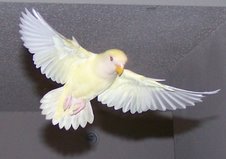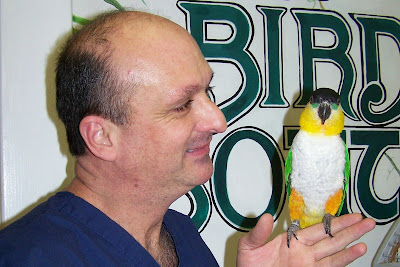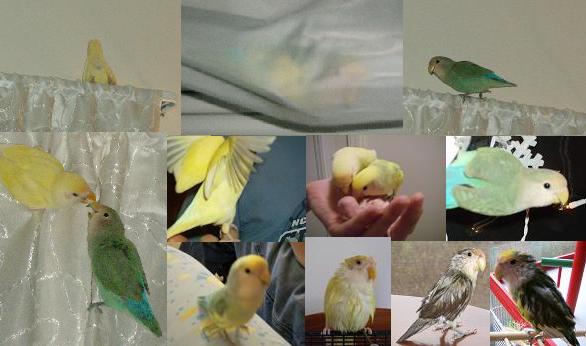Welcome!!!
We are the owners of an awesome E-Bird store (stuff for all birds of all sizes!) and Lovebird Aviary in Cary, NC. Our birds are quite popular because of their temperaments and socialization. Our dear Angel passed away on July 30th, 2007 and we lost our Evee on September 11, 2013. We have retired from breeding but are advocates of fostering and adoption!
True Love Aviary's Family
Highlights from 2005-2009
Availability:
Our Birdroom!
BeBe's Set-up for 1 Lovebird!
1 Cockatiel or 2 Lovebird Set-up
Parakeet or Budgie Set-up
Amazon Parrot Set-up
About our lovebirds:
Sunday, June 29, 2008
Friday, June 27, 2008
Cookie Update (Pictures!)
Posted by
Tamara
at
3:30 PM
2
comments
![]()
Labels: Adopted, Cookie, Family, Musical Babies, Nutriberries, Piccolo, Update
Thursday, June 26, 2008
Trinket & the Gi-normous Bug!!!
Posted by
Tamara
at
11:07 PM
0
comments
![]()
Labels: Babies, Blueberry, Bug, July Babies, Trinket, Update
Tuesday, June 24, 2008
Crazy Cockatiel!!! (video)
Posted by
Tamara
at
3:18 PM
1 comments
![]()
Labels: Antics, Ashlee, Cockatiel, Silly, Upside-down, Video
Sunday, June 22, 2008
Wet Bird Submission and Story!
*******************
This is why we do what we do here and on YouTube! Thanks so much Mona for sharing your story and your photo!!!
Posted by
Tamara
at
4:12 PM
1 comments
![]()
Labels: Lovebird, Photo Contest, Submissions, Wet Bird
Saturday, June 21, 2008
Wet Bird Submission!
Posted by
Tamara
at
7:01 AM
0
comments
![]()
Labels: Cockatiel, Photo Contest, Submissions, Wet Bird
Friday, June 20, 2008
New Videos!

Lovebird Cage Set-Up for 2 Lovebirds
Our Aussies Foraging
Posted by
Tamara
at
7:31 PM
0
comments
![]()
Labels: Ashlee, Budgie, Cage Set-Up, Cockatiel, Dewey, Foraging, Hedwig, Lovebird, Pigwidgeon, Sierra, Video
Wednesday, June 18, 2008
3 More Photo Submissions....
Posted by
Tamara
at
12:40 PM
1 comments
![]()
Labels: Bath, Lovebird, Parrotlet, Photo Contest, Splayed Legs, Submissions, Wet Bird
Saturday, June 14, 2008
More Photo Contest Submissions!
Posted by
Tamara
at
7:20 PM
2
comments
![]()
Labels: Bath, Lovebird, Photo Contest, Submissions, Wet Bird
Friday, June 13, 2008
Cockatiel Cage Set-up (Video)
Ashlee's Cage Set-Up! We felt it was important to show you how we set-up a cockatiel's cage!
Posted by
Tamara
at
2:15 PM
2
comments
![]()
Labels: Ashlee, Cage, Cage Set-Up, Cockatiel, Homemade Toys, Perches, Video, YouTube
Wednesday, June 11, 2008
A few photo submissions for the Contest!!
 LOL, not as wet as some Im sure, but wet none the less!
LOL, not as wet as some Im sure, but wet none the less!
Bird in Photo: Calliope caption: "why yes we DID just take a bath. how did you guess?"
caption: "why yes we DID just take a bath. how did you guess?"
Birds in photo: Kiwi (left), Lychee (right) caption: "post-bath-head-rub-on-shoulder
caption: "post-bath-head-rub-on-shoulder
Birds in photo: Lychee caption: "shower trance"
caption: "shower trance"
Birds in photo: Lychee
My fellow parrot lovers and I call this state the "shower trance." It is when the bird just gets SO relaxed in the shower that he/she gets a dazed look on their face and closes their eyes. PeeWee pre-bath!
PeeWee pre-bath! PeeWee post-bath!
PeeWee post-bath!
Posted by
Tamara
at
1:45 PM
4
comments
![]()
Labels: Bath, Budgie, Lovebird, Photo Contest, Submissions, Wet Bird
Sunday, June 8, 2008
Lovebird Breeder Flight Training
This shows you how we trained our wild lovebird breeders how to fly to us when we give them treat stimulation. They are, of course, a lot tamer now that we have been working with them for nearly 2 years! It's also another part of the taming process.
Posted by
Tamara
at
7:51 PM
0
comments
![]()
Labels: Dewey, Flight Training, Lovebird, Sierra, Treat, Video
Saturday, June 7, 2008
Bella & Apple Update!
This update is WAY OVERDUE!!! I think this was sent to us in March! Eeek! Sorry!
Hi Rodney & Tamara-
Bella & Apple are fabulous! I believe they are getting to the end of their first molt & they are both becoming so beautiful, and looking like grown up birds with all the bright colors. They are pretty inseparable. Bella is the boss and when she gets an ornery spell in her she will chase Apple around. Of course Apple had to have instigated it, but then he scampers away and wants to be held by Scot or I. I say he pouts to his parents when he does this:-)
Scot & I had an opportunity to go to Costa Rica for a week over Valentines! My parents were sweet enough to baby sit for us. When we got to their house Bella & Apple looked very calm but reserve about things. Never bothered, but just taking it all in. We sat their cage by the sliding doors so they could see out & my mom (who works out of the house) said they would talk with the Blue birds outside. Scot & I had a good time on our trip, but we never realized how much we could miss two little birds. When we walked in the house to pack them up and bring them back home, they couldn't hop out of the cage fast enough to see us.
I attached some pictures for you to see. They love the play gym we set up in front of our glass door. They usually take a bath every morning in the water bowl & sit on the branches and dry off in the sun. I also sent three pictures of Costa Rica.
I hope the Money family is doing well. And I will keep looking back at your website for the updates!
Jake & Irene Update!
 The caption should read: "Gosh Irene...this is a great place for a nest but do you think we can afford it?"
The caption should read: "Gosh Irene...this is a great place for a nest but do you think we can afford it?"~Pam
Have you ever considered having a photo contest??? Your Web site is great but it must be drag coming up with new content. You could try it this summer to generate "bonding among the flock" and before the next hatchlings arrive. I'd suggest a different category each month and post the top photo (and maybe a runner-up) on the Web site depending on how many people contribute. Categories would be good too. Here are three to consider:
So, yes, we will do a photo contest for the month of June!!! We will be accepting pictures of all types of birds and the first category will be: Bird Bath: HOW WET CAN A BIRD GET?! Send your photos and a caption along to trueloveaviary@gmail.com. Try and limit yourself to 3 photos per family! We will post the winners at the end of the month!! We may send a prize to the overall winner! How about a homemade toy???!!!
Coconut Update!
Hi Tamara & Rodney
6/5/07:
Last night was my mother's 79th birthday party and Coconut was the life of the party, he is such a sweet boy, he even went to the kids and they loved him. My cousin's daughter is afraid of birds, they told me she had a bad experience with a bird when she was a very little girl and she has been afraid ever since. Well she even let Coconut step up on her hand and sit on her shoulder, at first when he was on her hand she said to me, my stomach is doing lips, I'm really scared. I was ready to take Coconut from her and then she started letting him step up on one hand then the other hand over and over, so I left them alone and next thing she put him on her shoulder. My cousin said it was a break through. How about that.
He was tired out last night and went straight to bed, how cute!
God Bless
Pam
Posted by
Tamara
at
6:04 AM
0
comments
![]()
Labels: Adopted, Coconut, Family, July Babies, Update
Friday, June 6, 2008
A Thank You Note....
We got this via Email:
I would really just like to say that I love what you are doing for the bird world! I had a lovebird whose name was Shai and he was my first real pet and I miss him terribly, I recommend lovebirds to anyone who loves animals because they are amazing pets and amazing animals in general. I am hoping you will be doing this for many many years to come because I don't know where you are located from but when I am in a better position in a couple of years I would love to get a love bird from you. You are doing an amazing job from what I can see so please never stop doing what you are doing. I miss Shai and I can't wait for the day when I can share my love with another amazing lovebird so thank you for giving so many other people the chance to fall in love with these amazing birds! I know your busy people so I won't take up any more of your time, thanx again.
<3 Erica
Shai thanx you too!
Posted by
Tamara
at
11:59 PM
0
comments
![]()
Dewey & Sierra

Our Breeders: Creamino x Dutch Blue Pied Peach-Faced Lovebirds
The Next Generation....
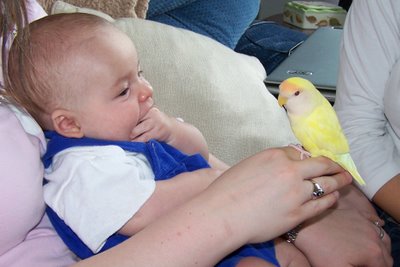
Of Bird Lovers!
Size Comparison

Each are 2 days apart (Youngest to Oldest: Left to Right)
Where People Get Their "Pet" Birds
Here are the options in the USA where people get their pet birds. I did not include shelters and second hand opportunities though; just where you would be more likely to find a parent-raised or handfed baby. Also, I will explain their level of tameness of the birds, care, the knowledge of the people who either work or run the establishments, and any other thing I can think of.
1. Large, retail petstore chains: (ex. Petsmart, Petco, Pet Supermarket, and other franchises, etc.)
This is the absolute worst place you could find a bird to call your own. Both Petsmart and Petco get their birds from the Kaytee Preferred Birds program which has two facilities located in Florida. They are also establishing one in Las Vegas. Of the two in Florida, one handles parent-raised small birds such as finches, budgies, and lovebirds which they buy from various mass production breeders, and one that mass produces larger parrot species for intention of handfeeding. All the breeders and babies are fed a medicated diet that includes vitamins and minerals, as well as antibiotics including Doxycycline for bacteria growth. The great use of these antibiotics will weaken the immune system and make the future successful use of antibiotics questionable. Kaytee does not care about the emotional development of their birds since they already have a contract with Petsmart and Petco stating they need to produce a quantity of chicks and not a quality of chicks to keep up with the high demand of sales. All the birds are shipped from Florida or Las Vegas, so you might as well be buying a wild-caught bird from Africa, Central and South America, or Australia. These birds are then quarantined for three days or put out on the floor when stock gets low. The stock room where the birds are quaranteed is a poorly lit dungeon only having human contact during feeding and cleaning. When at the store the birds are fed a very poor seed diet which leads to fatty liver disease and death (so with their weak immune systems, the stress of being shipped, and fatty liver disease, people wonder why their parakeet from Petsmart died in just a week?) The birds when placed out on the floor, especially the smaller birds, are cluttered together in cages with improper food, perches, and little to no toys. The so-called "experts" are usually teenagers in High School or college who could not tell the difference between a cockatoo and a macaw. The only time the birds are handled is if a customer is interested, because the employees and their employers do not want to risk damaging their merchandise. Handfed babies are fed Kaytee Exact Handfeeding formula which is hard to digest in the bird's crop. Employees and Employers are not worried about socialization of the babies; their only concern is to feed them as quickly as possible so they can bag up more fish, the true highest profitable merchandise, for customers. The only way to stop this travesty of mass production of chicks is education to the public to stop buying birds at retail pet centers.
2. Local Small Business-owned Pet Stores:
The knowledge of the staff varies greatly depending on the expertise of its people. Even with a very knowledgeable and educated staff, it is near to impossible to socialize each and every bird and care for their emotional needs. Employers and Employees have their minds preoccupied with cleaning cages, feeding birds, stocking, handling accounts, and simply dealing with customers; because first and foremost, it is a business. Many pet stores handfeed their own babies, but even the best bird stores forget that they need to continue socialization and establish a constant routine of playtime after they wean. Pet stores is where I see the vast majority of sweet, handfed babies turn wild after weaning.
3. Large-scaled Breeders:
Very similar to the suppliers of babies to the large retail pet chains. Large-scaled breeders mass produce large amount of babies for profit. So unless they have a staff that dedicates their entire time to feeding, playing, and socialization, the emotional needs just can not be met simply due to the sheer numbers of birds. These breeders are contracted to pet stores, other breeders for future stock, and other clients to provide a quantity of birds for future or present profit. Not all large-scaled breeders have inhumane practices. Steve Hartman of Hartman Aviaries and Gail Worth of Aves International not only care about their babies, but also the wellbeing of their parents also. Large-scale breeders also have the means to establish breeding stocks that could develop the possible domestication of parrots through line breeding. Also, mutations and other genetic changes could be studied in a more controlled environment.
4. Small-scaled Breeders (like us):
Many of these breeders are hobbyists, though some can make a living and breed for profit. These breeders tend to have a intimate relationship with each baby that they raise. This intimacy could lead in studies of developing co-parenting. Personally, I believe that this is the best place to find a new, loving feathered family member as long as the breeders breed in a moral way with not only thinking of the wellbeing of their babies, but also their parents. Small-scaled breeders tend to keep their pairs within their homes unlike large-scaled breeders who breed in either large flight aviaries or warehouses.
Our Lovebird Babies!

Cute, Tame, Playful, Well-socialized!
Pepsi or Coke?

I guess Pepsi, or not Diet!
Things We Have Learned as Birdie Parents:
Toys, Playgrounds, and Foraging for Parrots
1. Destructible toys that appeal to a parrot’s instinct to chew. These toys include: branches with bark, finger traps, bird candy, milled wood, chipped wood, straw, cholla, cork, leather, paper, jute, hemp, weaved palm leaves, etc.
2. Sound-related toys for the instinct to communicate. These toys include: bells, stainless-steel or nickel-plated liberty bells, metal pipe bells, plastic pipe bells, rattles, and clackers, bird music boxes, sound-repeating devices, and any toy with resonating properties from plastic, paper, or metal cups.
3. Interactive toys for the bird’s intelligence or emotional needs. These toys include: beads, puzzle toys, foraging toys, snuggling or comfort toys, hiding or peeking-out toys, surrogate enemy toys, foot toys, and mirrors.
4. Exercise toys for physical activity. These toys include: swings, appropriate perches, platforms, playgrounds or trees, and boings.
Foraging is simply the act of finding food. Very simple in definition, but great in the impact it can have on the lives of our birds. Having our parrots work for their food is one of the best stimulations that we can provide. It does not matter if you have a budgie, lovebird, amazon, or a macaw, behavior problems will diminish if a parrot has the opportunity to forage for their food rather than eating straight from a bowl. In the wild, a parrot will occupy 60%-80% of their time searching for food. During their mission, a parrot will fly, use problem-solving skills, and manipulate their environment to find that prized morsel. This is a very heart-wrenching revelation considering our parrots, according to recent scientific studies, on the average spend only 15 minutes eating from their bowls and the rest of their time waiting for us in their cage for eight hours while we are working. Our beloved birds want more and deserve more. Our feathered friends have provided richness, stimulation, beauty, and love in our lives; should we not also provide them with anything less? A parrot needs to work for their food to stimulate both body and mind; their health will reap from the benefits also. Providing foraging opportunities is more work on our part, but the rewards are far greater with the antagonists of our selfishness. As our Avian Veterinarian Dr. Burkett states, “We put them in cages, the least we can do is provide the absolute best for them.”
5. Foraging opportunities for parrots include, but are not limited to, the following: natural foods and treats such as nuts, Nutri-Berries or Avicakes; foraging toys made specifically for birds; shredded paper, paper towels, or toys in a food bowl; supervised foraging on a playgrounds, trees, toy boxes, or baskets; hiding treats wrapped in carrot leaves or dark leafy vegetables, placing food in pinecones or stuffed in children’s toys such as a small dartboard from the local dollar store; taking treats and arranging them in the cage in a sheskabob; shreddable cardboard boxes with hidden treats; wrapping treats in paper and hanging them inside the cage, perch, or playground; placing food bowls in different locations in the cage providing several feeding stations. Wrap food in paper, paper towels, or paper bags and place in some stations while leaving others empty. Then, tape the top of the feeding stations with paper, or a destructible toy, so your parrot will first have to punch through the barrier and then remove the wrapped morsel; placing food in the holes of a cholla perch or destructible toys such as finger traps; hiding food in bird safe, untreated pine toys or cardboard boxes found in a craft store; foraging trays with hidden food and toys placed on the bottom or top of cages, playgrounds, or trees; having your parrot climb a branch, rope, or chain to his food, having your parrot lift a bucket or string to retrieve his food; sticking food in plastic waffle balls, teach flight training and retrieving, and my favorite: either hiding food in your clothes, making a birdie edible necklace, or holding your parrot’s food up high so he has to climb up you to receive his treat and the rewarding positive stimulation of his favorite sound, your voice.

As you can see, foraging is only limited to the creativity of your mind. It always “cracks me up” when my lovebirds get so excited even when they just find some pellets buried under a mass of shredded paper towels. It will take you a few extra minutes a day to set up foraging opportunities and stations, but the rewards, positive stimulation, and environmental richness will last a lifetime in the lives of your beloved birds.
~Rodney Money
If you would like to use this article, just quote us as the source! That goes for any of our articles on here!
Bird Protectors
Chances are that at least once you have been browsing through the bird section of your favorite pet store and come across a product called a "Mite Protector". You may have wondered whether or not you need this product, and if it can really be beneficial to your pet's health.
A mite is a very small parasite that can infest the skin and feathers of most animal species. Truth be told, the vast majority of birds that were captive bred and have been housed in sanitary environments never experience a problem with mites or any other external parasites.
The "Mite Protectors" are usually small disc shaped containers designed to hang on the side of a bird's cage. The discs contain chemicals that release a fume to ward off mites, fleas, and other parasites -- but the fumes can potentially be harmful to the very thing you are trying to protect: your bird!
Birds have very sensitive and specialized respiratory systems, and the fumes given off by these Mite Protectors can be harmful or even fatal to them.
If you fear that your bird is experiencing a problem with mites or any other sort of parasite, the best thing to do is to schedule an appointment with an avian vet as soon as possible. Keep your pet healthy and happy by forming a good relationship with your vet and doing plenty of research on the bird products you are interested in before you use them.
Source: The Truth About Mite Protectors
Takes after his Daddy

Making music in another way!
Featured:
Feeding Schedule and Socialization Goals
2 weeks old: 5 feedings every 4 hours (8:00am, 12:00pm, 4:00pm, 8:00pm, 12:00am.) Many other breeders only feed 4 times every 4 hours the first week, but we do not want the babies crying for food in the middle of the night. Just like human babies, there are small babies (Pixy!) and there are large babies (her brother Jelly Bean!), so the amount of food is going to vary around 3.5-4.5 cc’s. Tamara and I do not say, “Ok baby, you have had 4 ccs, your full!” No, we fill up the babies until their crops resemble a full balloon or when they simply do not want anymore. Feed the babies all at once; competition is your greatest ally. Well-socialization goal: babies should recognize you, have a wonderful feeding response, and have names.
3 weeks old: 4 feedings every 4 hours (8:00am, 12:00pm, 4:00pm, 8:00pm.) Just fill those crops until they look and feel like a full balloon. At 3.5 weeks old, the babies will start to chew on their bedding. This is the time to introduce “big bird” food. Fresh, chewy Avicakes are the perfect introduction to solid food. Avicakes are highly nutritious unlike seed or millet. After babies are fed baby food, place a very small crumb into their mouths. This works great as a birdie pacifier also. We never feed them mashed-up or soft foods for weaning. Starting them on what they will eat as adults is best. After they are eating “big bird” food, we introduce small foot toys and toys they can shred. Well-socialization goal: babies try “big bird” food, recognize your voice, and step-up on your palm to be fed.
4 weeks old: 3 feedings every 6 hours (8:00am, 2:00pm, 8:00pm.) We never drop their feedings to three until we know they are eating the Avicakes on a regular basis. This is the time when we introduce crushed-up Nutri-Berries and a small pellet like Roudybush Crumble. Depending on the size of the baby, they should be receiving around 6 ccs at this point. Once again, feel the crop and if the babies refuse, do not force them to eat. After we feed them baby food, we place them over the solid food bowl. This is the time we introduce a small dish of water also. Well-socialization goal: babies play with toys, eating adult food on a regular basis, and cry out not only for baby food, but for attention also. Some of the older babies at this point have a natural protective instinct of their siblings and territory, so to dilute this trait we lay down on the floor, cuddle, play with them with their toys, and feed them adult food by hand after each feeding. When they have fallen asleep, we place them back into the brooder.
6 weeks old: 1 feeding per day at 6:00pm or 8:00pm (babies can feed from 7-10 ccs at this point.) If we have a large clutch, 4 or more babies, the prodigies will normally wean during this week. Well-socialization goal: babies are filling up on adult food in the morning, babies want to come out of their weaning cage to fly, cuddle, and most importantly play with toys independently on a playground. Babies should never be on a person all the time when they are outside of their cages. They have to learn independent play and have foraging opportunities.
7 weeks old: A baby should wean at anytime now. If they do not cry for their evening feeding, then do not give it to them. At 7 weeks, we introduce cooked foods, fruits, sprouts, and veggies. The babies will see the adults eating the food and will follow their lead. Many breeders and pet stores separate their babies in individual cages so they will not bond with each other. This is one of the worst things they can do for a baby, especially one that has not weaned yet. Birds need that competition of the food bowl, thus learning to eat on their own and whenever food is presented. Lovebirds that also learn to compete for food will naturally compete for your attention also thus making trust issues virtually nonexistent. Well-socialization goal: the babies step-up from inside their cage, and the babies are excited to see you. Babies need a reason to want to come out of their cages such as a playground. That, plus routine, is the key to a well-socialize parrot and not one that is caged bound and only finds security in the confounds of their bars.
8 weeks old: Weaned. If you decide to clip, never clip a bird before they wean or they might not ever see a reason to get off the baby food. This is nature’s way: stop begging, get off Momma’s fat baby food, and fly! Even though socialization starts as early as two weeks, true socialization actually starts the week babies wean. Too many times we have seen and heard stories of birds that were handfed, but they turned wild. It happens during this week. The babies no longer need you as a source of food, so you need to show them that they still need you for other reasons: love, another source of fun, security, and socialization. During this week, most birds forgot you ever handfed them. All handfeeding does is that it gets a bird use to the presence of humans. So during the week your babies wean, the most important thing any of us can do is to continue a balance of training, positive reinforcement, cuddle time, and independent play. Why is a well-socialized parrot such an important goal? The simple answer is because they will live with people. If a bird is truly trust worthy, affectionate, and socialized, then chances are their humans will see them more than just birds in a cage, but as true family members. Thus, living a full and enrich life in a human household. Well-socialization goal: babies enjoy a great head rub and have first full vet check from an Avian Veterinarian.
~Rodney Money True Love Aviary

















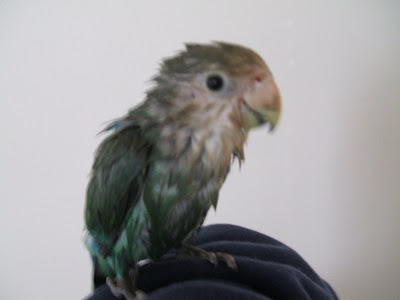












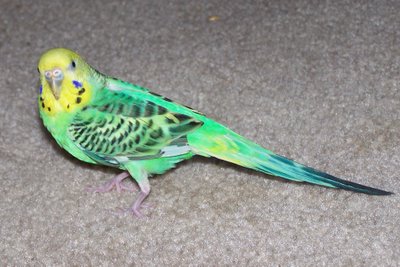
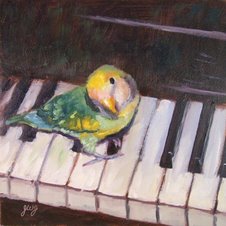
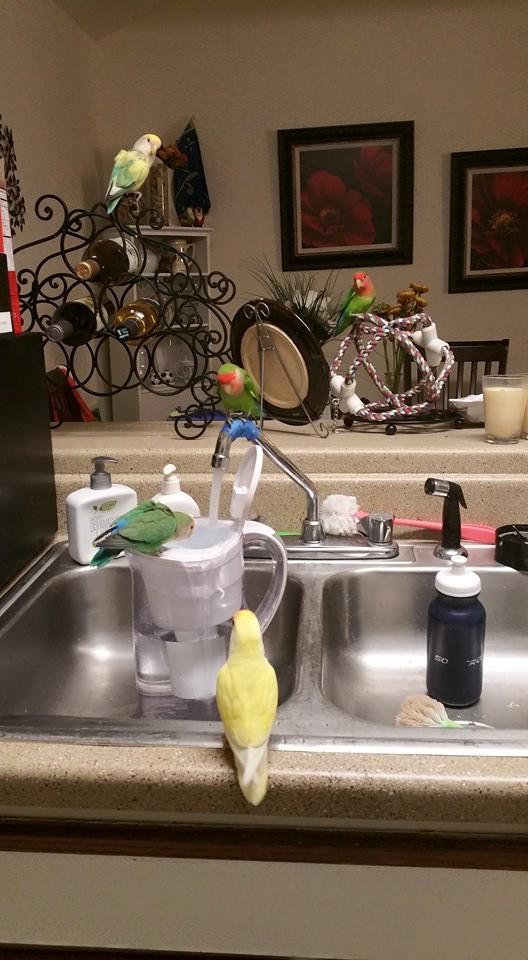














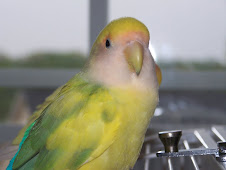

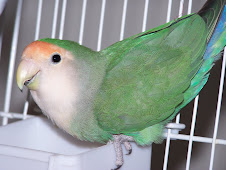



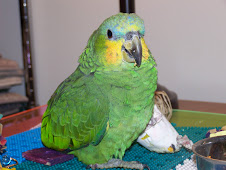
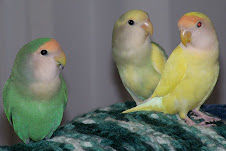


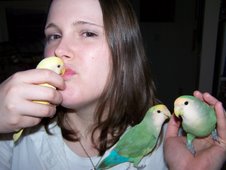
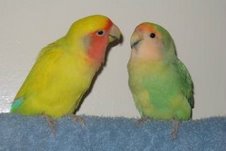
.jpg)
